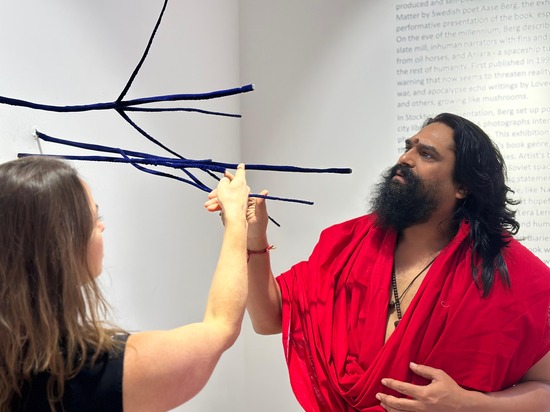Yogi Priyavrat Animesh’s Visit to the ‘DARK MATTER’ Exhibition: A Journey into Art, Consciousness, and Depths of Psychology
Drawing from his global journeys, Yogi Priyavrat Animesh reflected on how every culture uses art and literature as a means to probe the mysteries of existence.
New Delhi: The city became the epicenter of a profound fusion of art, spirituality, and science as Yogi Priyavrat Animesh visited the ‘DARK MATTER in Artists’ Book’ exhibition at Gallery ONKAF in the national capital recently. Inspired by Swedish poet Aase Berg’s book Dark Matter, the exhibition (Dec 7-17) explored humanity’s relationship with darkness, the subconscious mind, and creativity. Yogi Ji, who has traversed the globe—from the tranquil Swiss Alps to the dynamic cultural hubs of Germany, France, and Italy—infused this event with his wisdom, connecting it to deeper insights from neuroscience, psychology, and spirituality.

‘DARK MATTER’ takes its name from Aase Berg’s 1999 poetry collection, which warned of apocalyptic scenarios such as plagues, wars, and societal collapse. Featuring 40 books by artists from 8 countries (Germany, Israel, Estonia, France, Latvia, Spain, India and Russia), the exhibition presented “artists’ books”—unique creations that transcend traditional publishing by blending literature with visual artistry. These books, often born from the samizdat traditions of the post-Soviet space, symbolize resilience in expressing individuality even in restrictive circumstances.
Highlights included Tom Benson’s “black hole portals,” Nadia Adina Rose’s velvet branches spelling out apocalyptic hope, and Lera Lerner’s Non-Clair-Voyant Tarot Deck, merging human and post-human realms. Each artwork invited viewers to confront their inner complexities and navigate the unknown dimensions of consciousness.
Drawing from his global journeys, Yogi Priyavrat Animesh reflected on how every culture uses art and literature as a means to probe the mysteries of existence. In Switzerland, he observed how serene landscapes inspire deep reflection; in France, he experienced how art bridges life and philosophy. These experiences informed his understanding of the exhibition, which he described as a space that “invites humanity to confront its shadows.”
He said, “In every part of the world, I’ve seen people seeking light but avoiding the dark. This exhibition is a reminder that darkness is not an enemy but a dimension of reality. It represents the subconscious forces that drive us, challenge us, and ultimately lead us to growth.”
Yogi Ji delved into the psychological and neuroscientific implications of the exhibition. He compared the “black hole portals” in the artworks to the brain’s Default Mode Network (DMN), which governs introspection and self-awareness. He explained how the exhibition’s themes resonate with Jungian psychology, particularly the concept of the “shadow self”—the hidden, repressed parts of our psyche.
“These books are not mere objects; they are mirrors to the soul. Through their tactile forms, confessional narratives, and visual metaphors, they open a dialogue between the conscious and unconscious mind. This is not just art—it is a therapeutic journey for the mind and spirit,” he added.
Yogi Priyavrat Animesh emphasized the spiritual and psychological balance between darkness and light, drawing parallels with his teachings of yoga and meditation. He noted how works like Aase Berg’s poetry and other exhibited books challenge viewers to embrace their vulnerabilities and find strength in their shadows.
“In yoga, the balance between the solar and lunar energies is key to achieving harmony. Similarly, the human psyche must integrate its conscious and unconscious aspects to attain wholeness. This exhibition exemplifies this delicate equilibrium.”
Yogi Ji proposed a novel approach to using the exhibited artworks, such as the Non-Clair-Voyant Tarot Deck, as tools for meditation and self-discovery. He highlighted how these pieces serve as gateways to understanding one’s inner world, fostering emotional healing and spiritual growth.
“These books are not just stories or images; they are tools for introspection. By engaging with them in a mindful way, one can access deeper layers of the self and initiate a process of healing and transformation.”


